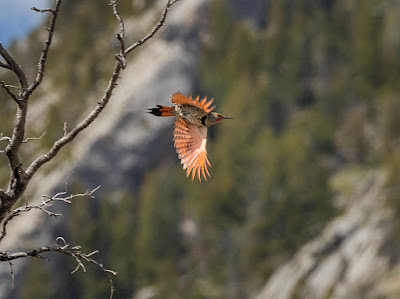 |
| Kelseya looks like a cross between moss and bonsai. A closer look reveals tiny leaf clusters from whose centers the flowers bloom. |
I like to think of myself as a flexible person, open to spontaneous adventure. But Facebook Memories reminds me that in regard to certain things, I am pretty much a creature of habit. For at least four of the last five years, Ken and I have made the hike to the top of Flatiron in the last week of May to search for blooming Kelseya. We knew that we were probably going to be too early this year because of the long winter and cool spring, and we were right. The flowers are just beginning to form and will probably be at their peak in another 10 days to two weeks. Unfortunately our calendar is pretty jammed for the next few weeks so we decided to make the trek anyway.
Because of the location of this particular patch of flowers, it is not easy to simply say we will be back another day. Thanks to the generosity of our neighbor in allowing us to park in his back field, we were able to do the trip in about 5 hours. Although there is no public access, we can actually hike directly from our place but it adds another difficult five miles onto an already tough eight mile hike. After parking the car, the first mile is a fairly flat walk across the prairie but then you bushwhack, occasionally catching a game trail, to the top, climbing approximately 2500' over the next three miles.
 |
| This plant is just beginning to form its beautiful red flowers.When in full bloom each flower will measure approx. 1/4" in diameter. |
Looking southeast from the top gives a view of Heart Mountain and the Clarks Fork River. The coolness of the day made for comfortable hiking and less haze in the distance.
 Another surprise discovery was this patch of Alpine Clematis growing from a crack in a limestone wall.
Another surprise discovery was this patch of Alpine Clematis growing from a crack in a limestone wall.I was photographing this Northern Flicker in a tree when Ken came over the ridge and spooked him. The sun caught his wings as he flew.
 On our way to the back field we saw a pair of Magpies dive-bombing something in a pile of rock. When I got out of the car to see what they were harassing I discovered this Long-tailed Weasel staring back at me.
On our way to the back field we saw a pair of Magpies dive-bombing something in a pile of rock. When I got out of the car to see what they were harassing I discovered this Long-tailed Weasel staring back at me. At certain elevations the Shooting Stars are in their prime.
The final image is a seven shot pano looking to the northwest from the top, along the Beartooth Front. It is easy to see why this is such a wildlife corridor in the winter months as the animals retreat to lower elevations from the snowy peaks. The Forest Service is considering allowing a four-wheeler trail all along this stretch, a move I believe would be disastrous for wintering wildlife.




No comments:
Post a Comment